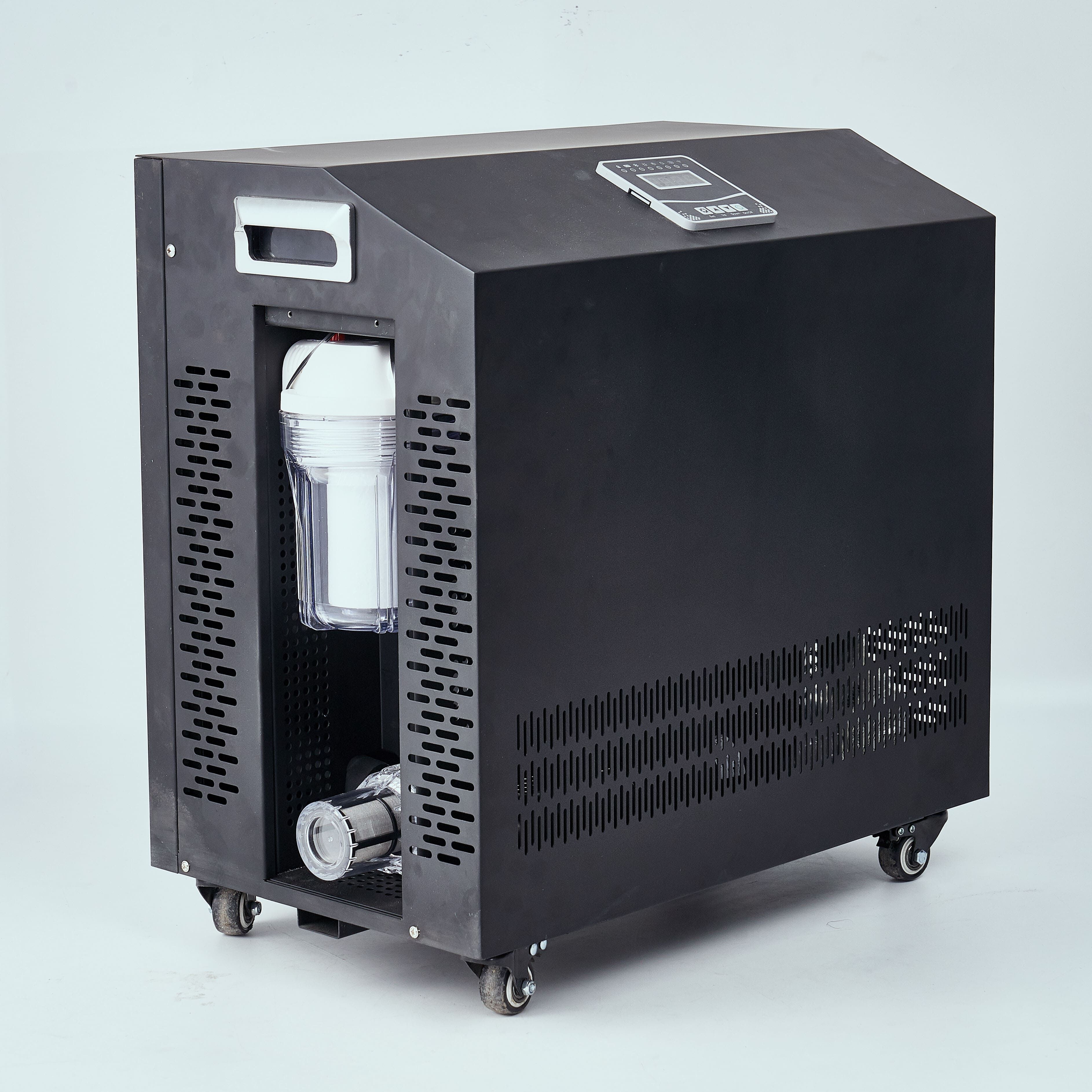Essential Features of a Portable Water Chiller
1. Compact Design and Mobility for On-the-Go Use
Portable water chillers work best when they're compact, which makes sense if we want to move them around easily during ice bath therapy sessions. Modern models have gotten much smaller and lighter over time, so transporting them between locations isn't such a hassle anymore. Compact designs really shine in situations where space matters most. Think about outdoor therapy setups, sports events where players need quick access to cold therapy after games, or those traveling PT services that go right to patients' homes. What's great about these compact units is how they maintain good cooling power despite their size. No need to sacrifice performance just because we need something that fits into a car trunk or moves between treatment rooms throughout the day.
2. Efficient Cooling Performance for Ice Bath Therapy
Getting good cooling going is really important when it comes to making ice bath therapy work properly. After all, these treatments depend heavily on what the water chiller does to keep things nice and chilly throughout. Most people measure cooling power using something called BTUs, basically telling us how fast and well a system brings down water temps for those cold plunges after workouts. Athletes definitely notice the difference here. When chillers get the job done quicker and stay steady, recovery actually speeds up because there's less swelling and sore muscles afterward. Take a look at some research from the Journal of Sports Medicine though, they found that top notch chillers make a real dent in how long it takes to bounce back after events. Makes sense why so many pros are investing in better equipment these days.
3. Energy Efficiency and Quiet Operation
When it comes to portable water chillers, how much power they use matters a lot, particularly when thinking about what it will cost to run them month after month. Chillers that have good energy ratings basically eat up less electricity, so people save money on their bills in the long run plus help out the environment too. Another thing worth mentioning is noise levels. Some chillers come with special tech that makes them run quieter than others, something folks really appreciate whether they're chilling at home during therapy sessions or working in a clinic setting. Most consumer guides always point out these two factors together because people want machines that work well but don't create background noise. That's why many therapists and home users go for chillers that are both efficient with electricity and operate quietly, since they fit better into spaces where peace and quiet are important parts of the treatment process.
Benefits of Portable Cold Plunge Chillers
1. Precise Temperature Control for Optimal Recovery
Keeping the water at just the right temperature during cold plunges makes all the difference when it comes to getting back in shape after workouts. When temperatures stay steady, muscles actually recover better and swelling goes down faster. Most good quality portable chillers these days come equipped with fancy temperature controls, including those digital readouts that let users set exactly what they want. Research points to this being true too many people who stick to proper temps report feeling recovered quicker than others. Anyone serious about improving how fast they bounce back from training sessions should really consider spending a bit extra on equipment that lets them fine tune those cold water settings.
2. Eliminating Reliance on Ice for Consistent Cold Water
Ice has its problems, mostly because it melts unevenly and we all know what happens when the supply runs out mid-session. That's where portable chillers come in handy. These devices deliver consistently cold water right away, so no more fiddling with ice bags or worrying about melting blocks. The water stays at just the right temperature throughout the session, making those cold plunges actually work as intended. From a money standpoint, running a chiller makes more sense than constantly purchasing ice bags. Sure, there's an upfront cost, but over time it saves quite a bit compared to buying ice week after week. People who use chillers report fewer headaches about preparation and more focus on getting their recovery sessions done properly without interruptions.
3. Long-Term Cost Savings vs. Traditional Methods
Looking at the big picture, portable chillers actually end up saving money compared to those old school ice baths. Sure, buying one upfront costs more than just grabbing bags of ice from the store, but think about all that time spent refilling containers and dealing with melting problems. Chillers run smoothly without needing constant attention and they consume way less electricity in the long run. Athletes who work with recovery specialists know this already. These professionals point out that chillers maintain stable temperatures throughout sessions which means better results every time instead of inconsistent effects from regular ice packs. Plus nobody wants to waste money on ice that just melts away before it can work properly. For people committed to cold water therapy, spending on a good quality chiller makes sense both financially and medically speaking.
Choosing the Right Water Chiller for Cold Tubs
1. Matching Chiller Capacity to Tub Size
Matching the chiller capacity to the cold tub size remains essential when choosing equipment. Most chillers are rated by their output in gallons per hour or liters, so this needs to match what the tub actually holds if proper cooling is going to happen. Take a typical 100 gallon tub as an example case study. Experience shows that something around 550 gallons per hour works well enough to keep things at just the right chilly temperature without overworking the system. The good news is manufacturers usually publish sizing charts somewhere in their documentation materials or will give pointers when asked directly at point of sale. Following those manufacturer specs makes all the difference between getting value for money spent versus dealing with inconsistent results down the road.
2. Evaluating Durability and Weather Resistance
When picking out a water chiller, durability really matters, particularly when it needs to handle different environments over time. Good quality chillers often feature parts made from materials that resist rust and wear down slowly, like stainless steel components that stand up well against harsh weather conditions. Such construction means the equipment won't break down easily even after exposure to rainwater or temperature extremes outside. Many manufacturers also throw in longer warranties these days, something worth noting because companies typically only offer this kind of coverage for products they know last a long time. A quick look at what warranty comes included gives buyers a pretty good idea about how tough the machine actually is before spending money on it.
3. Smart Features: Digital Controls & Filtration Systems
Today's water chillers come packed with smart tech that really improves how they work and feel to use. The digital controls let people set exact temps with ease, which means cold water therapy becomes something anyone can adjust to their liking without hassle. Integrated filtration systems play a big role too in keeping the water clean and fresh throughout each session. These filters actually grab all sorts of stuff out of the water before it gets into the tank, so folks don't have to worry about getting sick after jumping in. People seem pretty happy with these upgrades generally speaking. Market research indicates most buyers now look specifically for chillers that offer both good digital control options and solid filtration performance when shopping around. With all these improvements happening lately, there's no doubt that smart tech continues to make those icy dips much more enjoyable overall.
Maintaining Your Ice Bath Chiller System
1. Regular Cleaning and Sanitation Protocols
Keeping an ice bath chiller running smoothly depends on regular maintenance that extends both its life and how well it works. Most people find that sticking to a basic cleaning schedule makes all the difference. Start by making sure everything's powered down and unplugged before getting started. Grab some gentle soap and a soft rag for wiping surfaces clean, steering clear of anything abrasive that might leave scratches or cause damage. Afterward, give everything a good rinse with fresh water to wash away whatever soapy stuff remains. Many operators suggest doing this whole routine once a week because it really helps stop those annoying mineral deposits from forming while maintaining proper hygiene throughout the system. And let's face it, nobody wants their expensive equipment breaking down prematurely when simple weekly care could have kept things running just fine.
2. Seasonal Maintenance for Year-Round Use
Ice bath chillers need regular seasonal TLC if they're going to last through all four seasons. When putting one away for the winter months, make sure to drain every last drop of water from the tank and let everything dry completely before storing. Mold and mildew love damp environments after all, and those little guys can really mess with how well the system works later on. Come springtime when folks start using them again, check that all the fittings are tight and look around for cracks or corrosion spots that might have developed over time. Keeping track of routine maintenance stuff like checking thermostat settings and running filter tests makes a big difference in how reliable these units stay. Most people who've owned chillers for years will tell anyone who'll listen that proper seasonal maintenance keeps their equipment running smoothly no matter what kind of weather rolls around outside.
3. Troubleshooting Common Performance Issues
Keeping an ice bath chiller running smoothly means dealing with those little hiccups when they pop up. Most people run into similar troubles over time, things like erratic temperatures or strange sounds coming from nowhere. Start with the basics first. Check all the connections to see if any have come loose, look at the filters to make sure nothing's clogged them up, and tweak the thermostat setting if needed. Many folks report getting good results from these basic fixes without ever needing to call someone out. When problems stick around though, there's plenty of wisdom floating around online from others who've been through similar situations. They share tips on what worked for their chillers specifically. Taking this hands-on approach saves money on repairs and keeps the cold flowing consistently during those important recovery sessions after workouts.

